THE ELEGANCE AND LUXURY OF AVENUE MONTAIGNE, PARIS
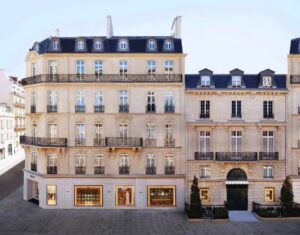
For anyone with an interest in high fashion, it’s generally acknowledged that Paris is a world leader, if not the leader, in haute couture. For decades, the top street for Parisian couture houses was the Faubourg St Honore. It was his desire to assert his own vision and originality that Christian Dior opened his couture house in 1947 on Avenue Montaigne, rather than the Faubourg St Honore. Since then, this short road has gradually seen many of the top fashion houses establish themselves here, and nothing says “fashionista” more than an address on Avenue Montaigne.
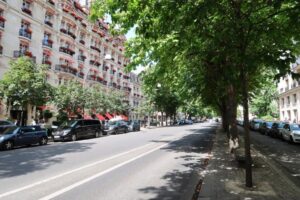
The beautiful Avenue Montaigne is located in the 8th arrondissement, between the Rond Point des Champs Élysées and Place de l’Alma near the Seine. It’s a relatively short street at less than a kilometre long. At the river Seine end, the avenue leads to a breathtaking view of perhaps the most famous structure in Paris, the Eiffel Tower.
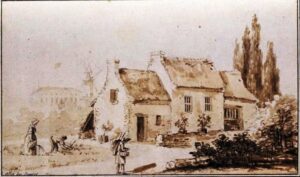
In writings from the 17th century, the Avenue Montaigne is referred to as a simple path along which vegetables were grown. In 1770, the avenue was planted with a double row of elms by order of the Marquis de Marigny and was nicknamed Allée des Veuves, because it had become a gathering place for women in mourning. Over time, it had gained the reputation as the place to meet some these often lonely women who were in search of a discreet “gallant” adventure. It was not the elegant, refined place we know today.
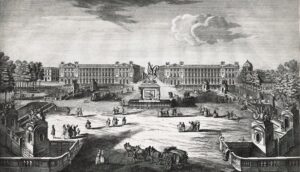
The Allée des Veuves gained a certain notoriety when, in September 1792, at the foot of one of the elm trees in front of the house of a certain Dame Brûlée, some of the French crown jewels that had been stolen earlier that month, had been buried. The royal jewels had been stored at the Garde-Meuble (now the Hotel de la Marine) that faces onto Place de la Concorde. The thieves had split up the jewels into numerous packages and secreted them in a number of locations throughout the city. The small haul recovered from Allée des Veuves had been buried there by one of the thieves, who divulged the hiding place in order to avoid the guillotine.
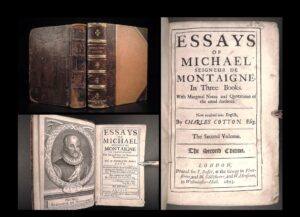
In 1850 the street was re-named after French Renaissance statesman and philosopher, Michel de Montaigne. During the Universal Exhibition of 1855, the Palais des Beaux-Arts was built there by the architect Hector-Martin Lefuel, and elegant houses began to be built along the avenue, becoming one of the most fashionable places in the Champs-Elysées district.
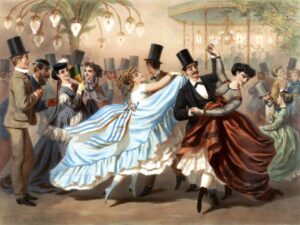
Paris has long been famous for dance, and during the 19th century like those we’ve seen in numerous Impressionist paintings of the era, around Montmartre. Avenue Montaigne also earned renown for its sparkling and colourful Bal Mabille (Mabille Gardens) on Saturday nights. This open-air dance venue opened in 1831, when the area had large parts that were still vegetable gardens. It was struck by shells during the siege of Paris in 1870-71 during the Franco-Prussian War, and ultimately had to close in 1875 and was demolished in 1882. Under the Third Republic, there was a shooting range, as well as an orchestra there led by a well-known conductor and composer of the time, Olivier Métra.
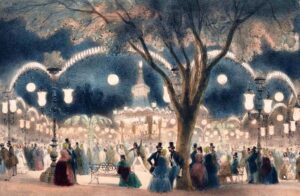
The Bal Mabille extended from nos. 49 to 53 in the modern street numbering. It was opened by Monsieur Mabille, one of the city’s innumerable dance instructors, and was originally for his pupils. It was later opened to the public. His son refurbished it as a sort of enchanted garden, with sand paths, lawns, trees and shrubs, galleries and a grotto. It was equipped with 3,000 gas lamps, very modern for the time, and was thus able to stay open after dark. Coloured glass globes illuminated the areas under trees, and strings of lights and chandeliers were suspended between them. There was an area with a roof for weather protection, and the grounds contained a Chinese pavilion, artificial palm trees and a merry-go-round. The entrance fee was quite high, so that only the relatively well-to-do were able to frequent the establishment.
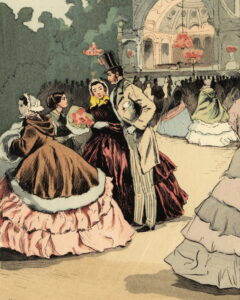
It soon became the most fashionable dancing location of the period, although it had a reputation for attracting more foreigners in search of “pretty faces” than Parisians. The garden also had a reputation as being a place where gentlemen could meet prostitutes.
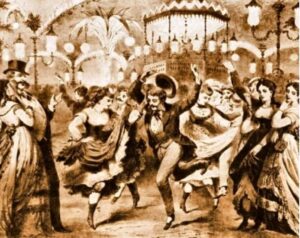
The polka was introduced there by Elise Rosita Sergent, known as la Reine Pomare, and another dancer known as Céleste Mogador. As well, the can-can is said to have been invented there–not up at Montmartre as we tend to think–and crowds flocked to watch the famous Céleste Mogador dance it.
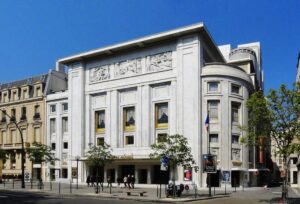
As well as famous fashion houses, the Avenue Montaigne has a couple of other landmarks. One of these is the Théâtre des Champs Élysées at no. 15. The theatre is named not after the famed Avenue, but rather after the neighbourhood in which it’s situated. Commissioned by a famous impresario of the day, Gabriel Astruc, the theatre was designed by French architect Auguste Perret to provide a venue suitable for contemporary music, dance and opera, in contrast to the traditional institutions like the Paris Opera. Inaugurated on 02 April 1913, it was the first example of Art Deco architecture in the city, and the first Parisian theatre to be entirely built in reinforced concrete instead of steel. It has 3 auditoriums, the largest having 1,905 seats.
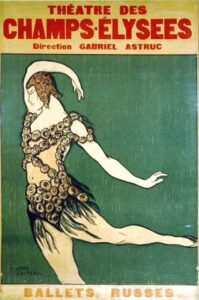
The opening show was the world première of Igor Stravinsky’s ‘The Rite of Spring’, performed by Sergei Diaghilev’s Ballets Russes company, with choreography by Vaslav Nijinsky. The opening night at the Theatre on 29 May 1913 caused a sensation, with many reports describing the reaction as a riot or near-riot, due to the avant-garde nature of the music and choreography. The artist Jean Cocteau wrote about the reaction of the first night’s audience saying “…It immediately rebelled. It laughed, scoffed, whistled, cat-called, and perhaps might have got tired in the long run if the mob of aesthetes and a few musicians in their excessive zeal had not insulted and even jostled the people in the boxes. The uproar degenerated into a free-for-all.”
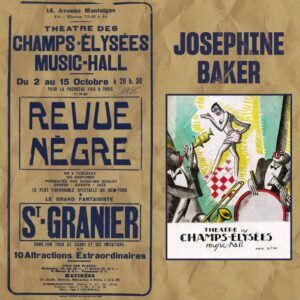
Since that memorable start, the theatre has become known as a venue of innovative programming for opera, recitals, orchestral concerts, and dance featuring a wide variety of artists ranging from the magnificent cabaret dancer Josephine Baker, Louis Armstrong, Ella Fitzgerald, Oscar Peterson, Igor Stravinsky, Richard Strauss, Andreas Schiff, the Staatskapelle Dresden and the Vienna Philharmonic among so many other internationally famous performers. The Théâtre des Champs Élysées was one of the first modern edifices to become a listed building, when in 1970 it was registered as a Monument Historique.
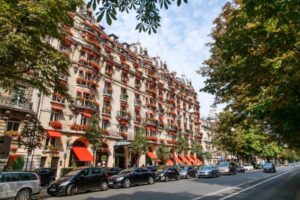
One of the most famous landmarks on Avenue Montaigne is the Hôtel Plaza Athénée at no. 25. With incredible views of the Eiffel Tower, the hotel has long been regarded by many as the foremost luxury hotel in the area since its opening in 1913—the same year as the Théâtre des Champs Élysées—and has been the hotel of choice for guests such as Grace Kelly, Jackie Kennedy, Rudolph Valentino, and Sophia Loren.
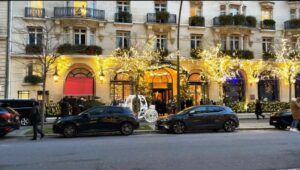
The hotel is far too discreet to discuss any more recent famous guests! Its history is interwoven with that of its neighbour, the Théâtre des Champs Élysées, which opened within weeks of the hotel, and became a haunt for both composers and theatregoers. The hotel is now part of the Dorchester Collection that includes Le Meurice, also in Paris, London’s Dorchester Hotel and numerous prestige hotels in major European and American cities, as well as Dubai.
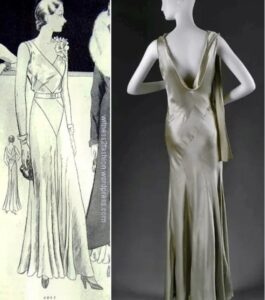
By the early 1920s, a few major fashion designers had set up shop along the avenue, such as the Callot sisters and especially their former employee, Madeleine Vionnet, who set up her fashion house in a private mansion at no. 50. She pioneered the revolutionary ‘bias-cut’ dress, draped expertly over the body, which changed the shape of women’s fashion. She became known as the “Queen of the bias cut” and “the architect among dressmakers.”
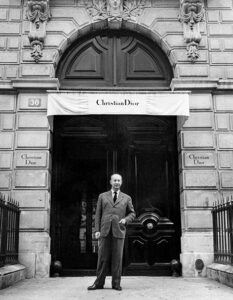
The name that springs to mind though, when thinking of couture, is of course Christian Dior. He opened his atelier at no. 30 Avenue Montaigne on 16 December 1946, although today the current Dior corporation celebrates 1947 as the opening year. Dior first set eyes on the hôtel particulier in 1946, declaring later that “it had to be 30 Avenue Montaigne. I was going to settle here and nowhere else!” The four-storey residence had been built in 1865 for the illegitimate son of Napoleon 1. The couturier said he was drawn to the understated elegance of the neoclassical façade, as well as its relatively modest scale and proximity to the elegant, cosmopolitan clientele staying at the Hôtel Plaza Athénée. In homage, Dior’s first collection included creations called ‘Plaza’ and ‘Athénée’.
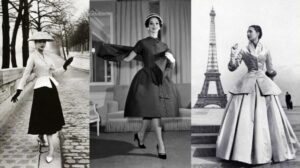
Dior showed his first collection of 90 garments on 12 February 1947. It became known as the “New Look”, when Carmel Snow, editor-in-chief of Harper’s Bazaar magazine, who admired the originality of the collection, and congratulated the designer, praising him by saying “It’s quite a revolution, dear Christian! Your dresses have such a new look!” When the ‘New Look’ became the talk of fashion, it transformed the fortunes of both Dior and France. It came at an ideal time. Resurrecting themselves through fashion, among other industries after WW2, France and Dior were beginning to create a new identity.
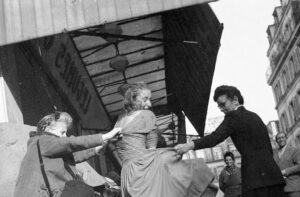
For many, the collection’s lavish sense of exaggerated femininity marked a welcome departure from wartime austerity. However, from others it prompted harsh backlash, as Dior’s styles, which used metres and metres of fabric for a single dress, was offensively wasteful.
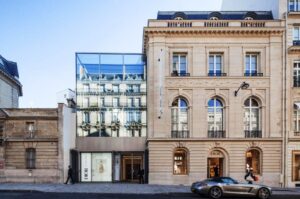
The success of the House of Dior necessitated an extension being added to 30 Avenue Montaigne. A year later, the neighbouring 11b, 13 and 15 rue Francois 1er were also rented to accommodate the 25,000 people travelling to see the Dior collections each season. Today, one of the Must Sees in Paris is the beautiful Galerie Dior museum, accessed from the rue Francois 1er side. You can read more about this gorgeous venue in a blog I wrote when it first opened post-COVID: https://parisplusplus.com/paris/la-galerie-dior-a-homage-to-the-artistry-of-the-master-of-dreams/
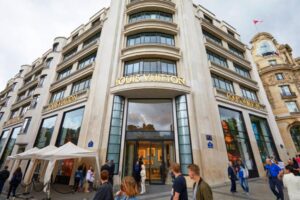
Today, Avenue Montaigne has a plethora of top designer boutiques, including Chanel at no. 51—although their flagship store is in rue Cambon—Louis Vuitton at no. 19, Balenciaga at No. 57, Celine at No. 55, Yves Saint Laurent at No. 53.
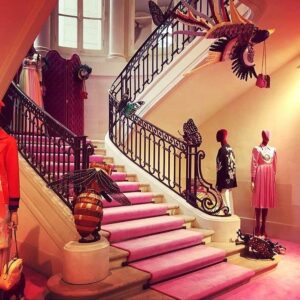
Gucci at No. 60 has an extravagant interior, Armani is at nos. 18 and 2, Valentino at no. 17. Versace recently opened a large new store extending over two levels, at no. 45.
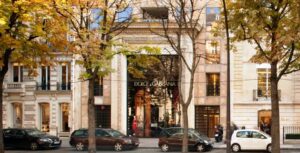
Other illustrious fashion houses include Dolce & Gabbana, Givenchy, Chloe, Ralph Lauren, Loewe, Jimmy Choo, Prada, Max Mara, Ferragamo, and Fendi. This list is by no means exhaustive, but just an indication of the prestige fashion labels in residence.
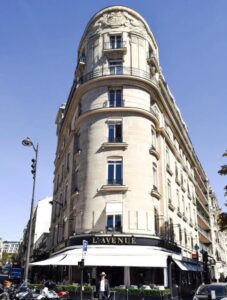
It’s not all high fashion though. Aside from the Plaza Athénée, there’s a great restaurant on the corner of 41 Avenue Montaigne and rue Francois 1er named L’Avenue, which describes itself as an upscale bistro—somewhat of an understatement, given the neighbourhood! There’s another hotel as well, the beautiful Hotel Montaigne at no. 6, self-described as being “in the heart of Culture and Haute Couture”.
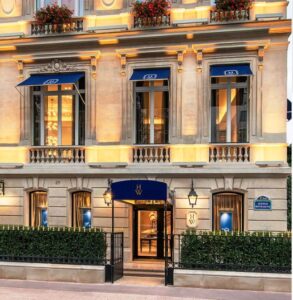
The street has had its share of notoriety in recent years. On 04 December 2008, the Harry Winston jewellery store at No. 29 was robbed of more than €80 million worth of diamond rings, necklaces and luxury watches by a gang of four armed men just before closing. It had also been robbed in October 2007, when a similar heist netted the robbers around €20 million.
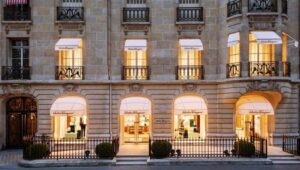
Famous residents of Avenue Montaigne have included the actress Marlene Dietrich, who maintained an apartment at No. 12 for many years, and died there in 1992. During her last years, Soraya Esfandiary-Bakhtiary (formerly married to the Shah of Iran) lived at No. 46. For many years, the Canadian Embassy was located at No. 35.

At the far end of the street, and just opposite, is the Pont d’Alma, chiefly known these days as the location where Princess Diana and her boyfriend Dodi Al Fayed died in a car crash in the tunnel just to the north of the bridge, back in August 1997. There is a memorial at the Place Diana, called the Flamme de la Liberte (Flame of Liberty), which is a replica of the torch of the Statue of Liberty in New York harbour. Given to France by the USA to celebrate Franco-American friendship, it became a spontaneous shrine to Diana. There are always bouquets of flowers laid at the base of the Flamme.
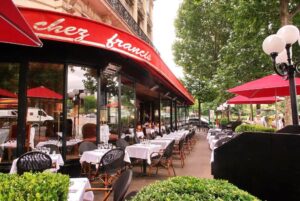
There are a couple of good brasseries at the intersection of Avenue Montaigne, Avenue George V and Avenue President Wilson, that we’ve eaten in whenever we’ve gone to a performance at the nearby Theatre des Champs Élysées. Metro Alma-Marceau (Line 9) is also at this intersection.
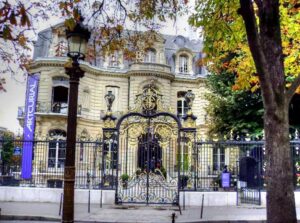
At the other end of Avenue Montaigne, one of the loveliest buildings in Paris is Artcurial, a contemporary art auction house in a magnificent historic mansion built in 1844 that overlooks the Rond Point. It’s set in lovely gardens and surrounded by a beautiful, cast-iron fence with heavily ornamental, gilded gates. Just around the corner is the Champs Élysées.
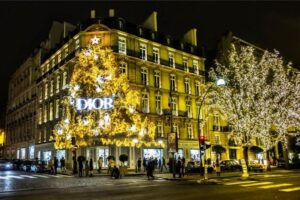
There is a lot to see in this very upmarket neighbourhood, and perhaps after checking out Avenue Montaigne, you could take a stroll along Avenues George V and Marceau to round out your day surrounded by luxury and high fashion!
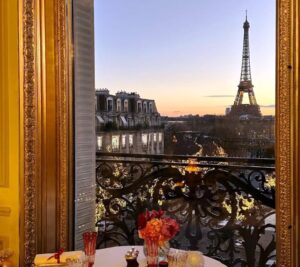


Oh to shop there with a gold credit card.
Yes, one needs to make sure there’s lots (and lots!) of space on the plastic before heading there. At least browsing is free! Cheers, Cheryl
Oh what beautiful buildings. What a shame Melbourne demolished so many beautiful old buildings only to be replaced with ugly high rise.
Hi Sandy,
Thanks for your lovely message. I absolutely agree with you about the destruction of fine buildings, all in the name of “progress”. Sydney is no better–in fact, worse, in my view–and one of the pleasures of visiting Melbourne in the past was its architectural heritage. What I love about the French is that they would man the barricades in defence of their culture and heritage, and this holds true throughout the country, not just in Paris. It’s something they hold very dear and regard it as essential to their sense of themselves and their placee in the world.
Best regards, Cheryl
Cheryl
What a wonderful overview of the top street for Parisian couture. Just imagining an afternoon or three with you walking this street. Possibly need to be your credit card though!
Anna
Hi Anna,
Glad you enjoyed the story. Yes, we often walk down Ave. Montaigne just for the pleasure of it, when we’re in that part of the city. Thanks for the offer of playing “credit card”, but I don’t think all mine and yours combined would get us very far in that street! Window-shopping is about as far as I’m able to go!!
Cheers, Cheryl